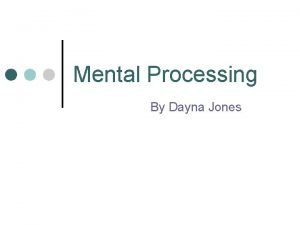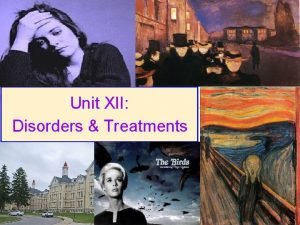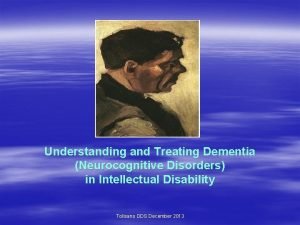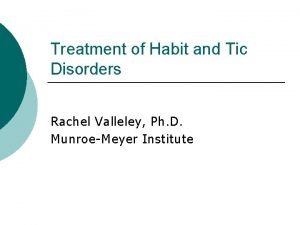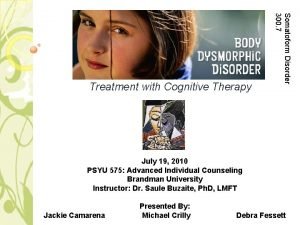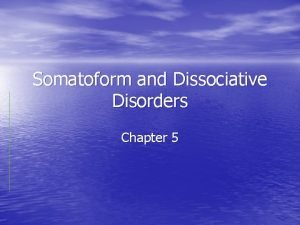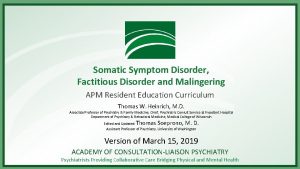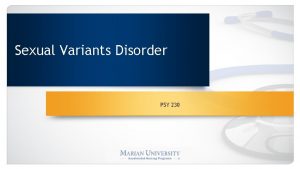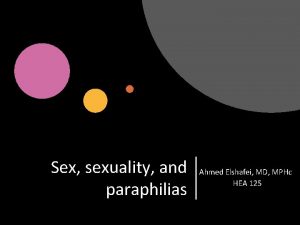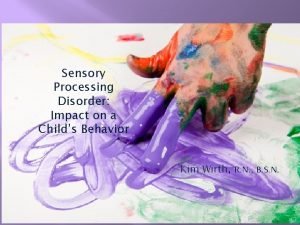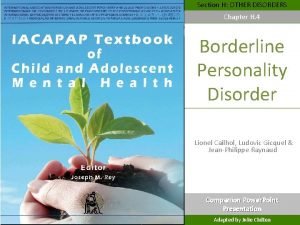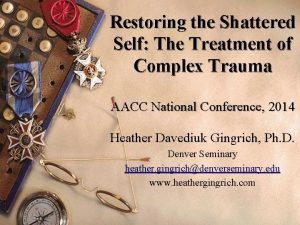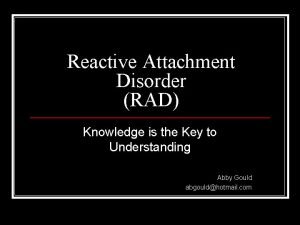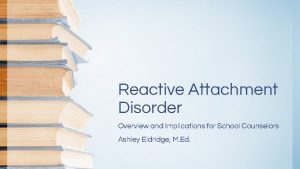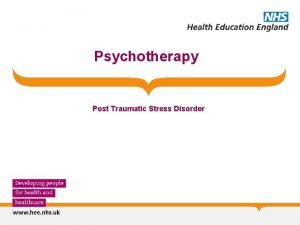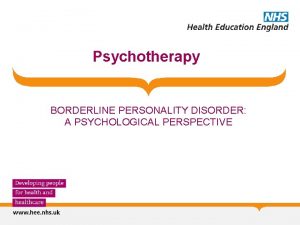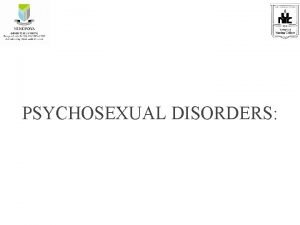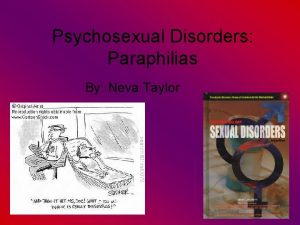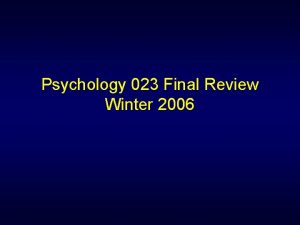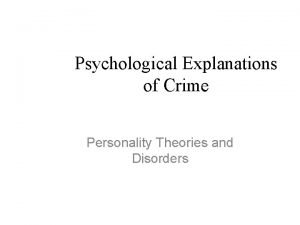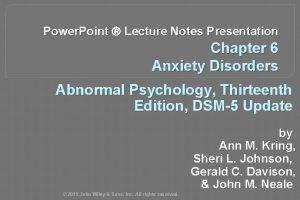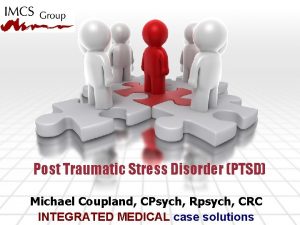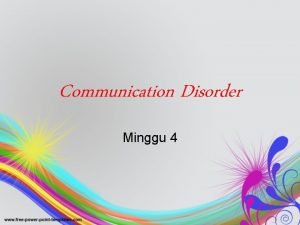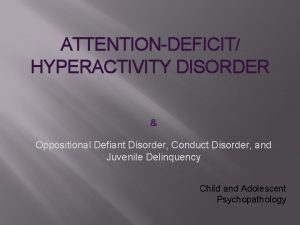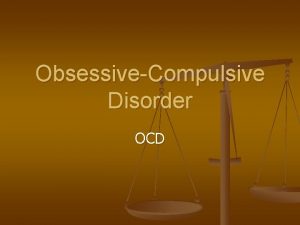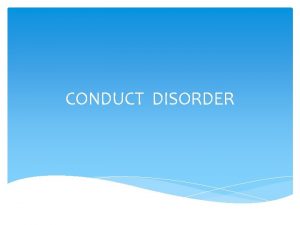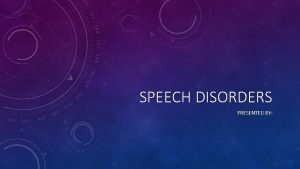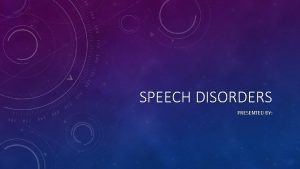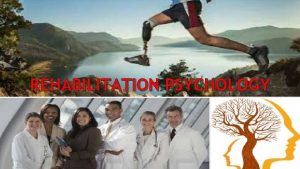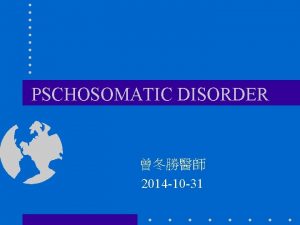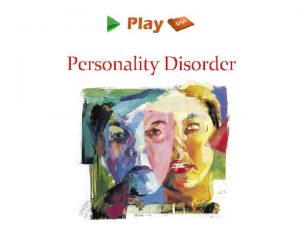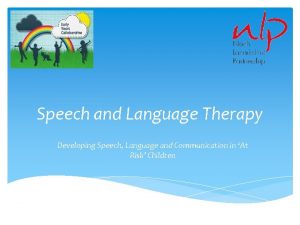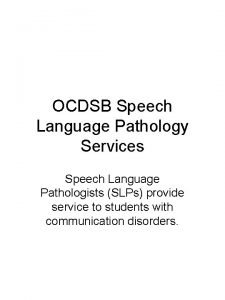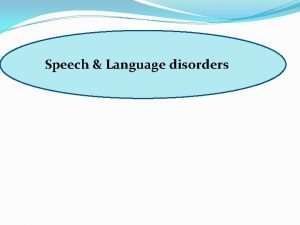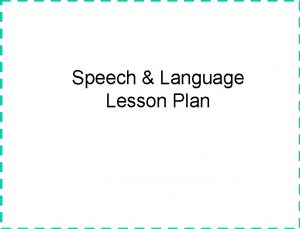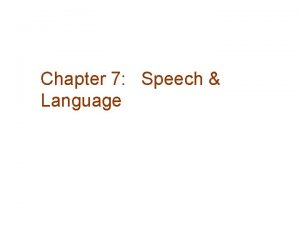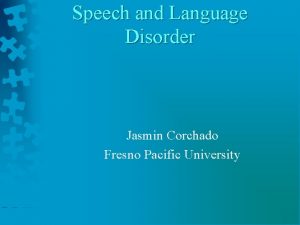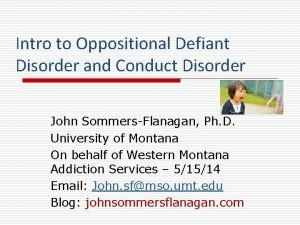Introduction to Speech Language Disorder 1 Speech Language

























- Slides: 25

Introduction to Speech Language Disorder 1

Speech Language Disorder 2

Introduction to Speech Language Disorder • Speech or language Impairment refers to a communication disorder, such as stuttering, impaired articulation, language or voice impairment that adversely affects a child’s educational performance. It refers to impairments in the areas of speech sound production, fluency, voice or language. • A communication disorder is any disorder that affects an individual's ability to comprehend, detect, or apply language and speech to engage in discourse effectively with others. • Gleanson (2001) defines a communication disorder as a Speech and Language Disorders, which refers to problems in communication and in related areas such as oral motor function. The delays and disorders can range from simple sound substitution to the inability to understand or use one's native language. 3

Communication Disorder according to ASHA • A communication disorder is an impairment in the ability to receive, send, process and comprehend concepts of verbal, non verbal and graphic symbol systems. A communication disorder may be evident in the process of hearing, language and speech. 4

Effect of Communication Disorders • Speech and language skills are essential to academic success and learning. Language is the basis of communication. Reading, writing, gesturing, listening, and speaking are all forms of language. Learning takes place through the process of communication. The ability to communicate with peers and adults in the educational setting is essential for a student to succeed in school. 5

Types of Communication Disorder or Speech Language Disorder Speech Disorder Language Disorder 6

7

Speech Disorder • Refers to atypical production of speech sounds or production that interferes with intelligibility in conversational speech. Articulation and Phonological Disorder. Fluency Disorders. Neurogenic Communication Disorder Voice Disorders 8

Causes of Speech Disorders Brain Damage. Abnormal Speech Mechanism. Physical Anomalies Speech Disorder 9

10

Language Disorder • Language Disorders are categorized as either receptive and expressive or both. A person with receptive language disorder has difficulty understanding language and a person with expressive language disorder has difficulty using language. • Language Disorder characterised by inadequate vocabulary, poor concept formation, unable to nonverbal communication with others and difficulty expressing personal needs. 11

Causes of Language Disorder • Brain Injury. • Genetic Causes. • Autism. • Learning Disability. • Attention Deficit with Hyperactive Disorder (ADHD) • Ear Infections or Hearing Loss. • No appropriate role / left alone often. • Not spoken to frequently / punished for speaking. • Ignored when trying to communicate. 12

“why do we use the separate term speech, Language and Communication when a single word label might be preferable? ” 13

Terminologies: - Speech, Language and Communication • A first question might be: “why do we used the separate term speech, Language and Communication when a single word label might be preferable? ” • The answer is that the three do not always go together, although impairments in one area may well influence development or competencies in another. • For instance, a child with speech sound disorder (SSD) typically produces a restricted range of speech sounds, rendering spoken output unintelligible. This is likely to affect the ability to communicate, because conversational partners may not always understand the intend meaning. 14

• Nevertheless the child may have normal language skills, understanding what others say and using grammatically complex sentences. She may also have a typical drive to communicate, supplementing impaired speech with gestures and reformulating spoken output in order to be understood. 15

• Another child with Developmental Language Disorder (DLD) may not have difficulties producing speech sounds, but his ability to communicate may be limited by poor understanding what others say to him, limited vocabulary, and reliance on simple and immature sentences. However, he may still use these limited language skills to share his thoughts and experiences with other peoples. • Very often speech, language and communication impairments occur in the context of another development disorder with a recognised label, for example ASD or Down Syndrome. In these cases descriptive terms such as Speech, Language and Communication impairment are very helpful in identifying the strength and weakness of a child’s Communication Profile. 16

Delay, Deviancy and Disorder. 17

• Speech and Language Delay: • A speech and language delay is when a child isn’t developing speech and language at an expected rate. It is a common developmental problem that affects as many as 10% of preschool children. • Deviant Speech and Language: • Deviant behaviour is any behaviour that is contrary to the dominant norms of society. 18

Cont. … • Speech and Language Disorder: • A disorder is a functional abnormality or disturbance. • A Speech and Language Disorder is any disorder that affects an individual's ability to comprehend, detect, or apply language and speech to engage in discourse effectively with others. 19

Description of Delay, Deviancy and Disorder. • Unfortunately, not all children progress easily in acquiring speech and Language Skills. It is a estimated that two to three percent pre-schoolers and about one percent of school age youngsters have Speech and Language Disorders. • Speech and Language Disability is not a Disease but a failure to learn, and there can be many reasons why certain children have trouble learning the hidden rules that govern our language. Children with Speech and Language Disabilities come with a wide range of differences. Some, as in profound Mental Retardation, appear to have learned none of the rules of our language, and their vocalizations have little meaningfulness. • The profoundly deaf, however, may have substantial language skills but they are expressed through sign language or the written word. There are nonverbal children who pauses language but who do not use it in speaking. The variety seems endless. But the great majority of children with language impairments just show delay in language development. 20

Cont. … • For one reason or another they are a year or more behind those who developed normally. Some seems stuck in the babbling and jargon stages; some have learned to speaking single words or noun and word phrases but seem unable to progress further. • Still others show marked delay in acquiring the phonology the sounds of our language, and cannot be understood. And there are some children who show not merely delayed speech and language but also deviant forms. They seem to have invented not only their own words for thing and actions but also their own ways of combining them. • They have invented a language of their own, and if the parents learn their language, they will never learn ours. However Curtiss, Katz, and Tallal (1992) have shown in their longitudinal study, most speech and language impaired children show delay rather than deviance. 21

Impairment Disability Handicap 22

WORLD HEALTH ORGANIZATION 1980 Impairment Disability Handicap Definition Any loss of abnormality of psychological, physiological or anatomical structural or function. Any Restriction or lack (resulting from impairment) of ability to perform an activity in the manner or within the range considered normal for human being. Any disadvantages for a given individual (depending on the age, sex, and social culture factors) resulting from an impairment or a disability that limits or prevents the fulfilment of a role that is normal for that individual. Level Organ / Pathology Functional Social / Societal Examples Hearing Loss Inability to Hear, difficulty ? ? ? ? ? ? in hearing. ? ? ? ? 23

Cont. …. . Characteristics Impairment Disability Handicap Impairment is characterized by losses or abnormalities that may be temporary or permanent, and that include the existence or occurrence of an anomaly, defect, or loss in a limb, organ, tissue, or other structure of the body, including the systems of mental function. Impairment. represents exteriorization of a pathological state, and in principle it reflects disturbances at the level of the organ. Disability is characterized by excesses or deficiencies of customarily expected activity performance and behaviour, and these may be temporary or permanent, reversible or irreversible, and progressive or regressive. Disabilities may arise as a direct consequence of impairment or as a response by the individual, particularly psychologically, to a physical, sensory, or other impairment. Disability represents objectification of an impairment, and as such it reflects disturbances at the level of the person. Handicap is concerned with the value attached to an individual's situation or experience when it departs from the norm. It is characterized by a discordance between the individual's performance or status and the expectations of the individual himself or of the particular group of which he is a member. Handicap thus represents socialization of an impairment or disability, and as such it reflects the consequences for the individual- cultural> social, economic, and environmental - that stem from the presence of impairment and disability. 24

Than. Q 25
 Conversion vs somatic symptom disorder
Conversion vs somatic symptom disorder What causes expressive language disorder
What causes expressive language disorder Bipolar disorder meaning
Bipolar disorder meaning Neurocognitive disorders
Neurocognitive disorders Stereotypic movement disorder
Stereotypic movement disorder Somatization disorder
Somatization disorder Somatoform disorders
Somatoform disorders Body dysmorphic disorder
Body dysmorphic disorder Dissociative identity disorder
Dissociative identity disorder Hoarding disorder بالعربي
Hoarding disorder بالعربي Arousal disorder symptoms
Arousal disorder symptoms Paraphilia disorders
Paraphilia disorders Sensory processing disorder dsm
Sensory processing disorder dsm Adhd and borderline personality disorder
Adhd and borderline personality disorder Dissociative disorder not otherwise specified
Dissociative disorder not otherwise specified Reactive attachment disorder
Reactive attachment disorder Reactive attachment disorder definition
Reactive attachment disorder definition Cptsd
Cptsd Emotionally unstable personality disorder
Emotionally unstable personality disorder Gerontophilia symptoms
Gerontophilia symptoms Psychosexual disorder
Psychosexual disorder Gratification disorder
Gratification disorder Cluster b
Cluster b Protraction disorders
Protraction disorders Classical conditioning panic disorder
Classical conditioning panic disorder Post traumatic stress disorder
Post traumatic stress disorder

